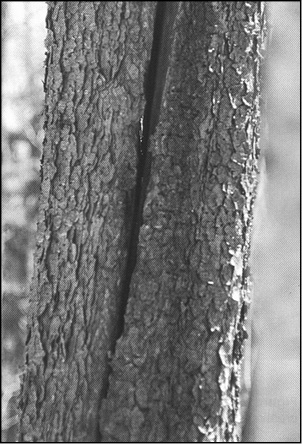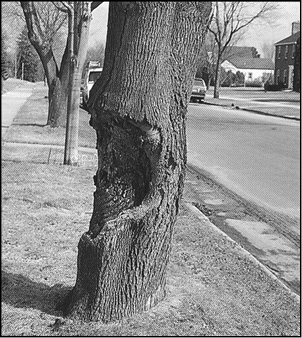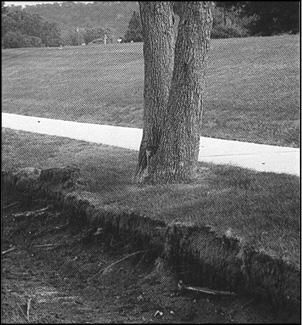
Appendix: Recognizing Hazardous Defects in Trees
— Information and Photos Courtesy of the USDA.—
Introduction
Trees add to our enjoyment of outdoor experiences whether in forests, parks, or urban landscapes. Too often, people are unaware of the risks associated with defective trees, which can cause personal injury and property damage. Interest in hazard tree management has increased in recent years because of safety and liability concerns resulting from preventable accidents. Recognizing hazardous trees and taking proper corrective actions can protect property and save lives.
A “hazard tree” is a tree with structural defects likely to cause failure of all or part of the tree, which could strike a “target.” A target can be a vehicle, building, or a place where people gather, such as a park bench, picnic table, street, or backyard.
Because of the natural variability of trees, the severity of their defects, and the different sites upon which they grow, evaluating trees for hazardous defects can be a complex process. This publication presents guidelines, not absolute rules for recognizing and correcting hazardous defects. When in doubt, consult an arborist.
What to Look For
Hazardous defects are visible signs that the tree is failing. Arborists recognize seven main types of tree defects: dead wood, cracks, weak branch unions, decay, cankers, root problems, and poor tree architecture. A tree with defects is not hazardous unless some portion of it is within striking distance of a target.
Dead wood
Dead wood is “not negotiable” — you must immediately remove dead trees and large dead branches. Dead trees and branches are unpredictable and can break and fall at any time. Dead wood is often dry and brittle and cannot bend in the wind like a living tree or branch. Dead branches and tree tops that are already broken off — “hangers” or “widow makers” — are especially dangerous.
Take immediate action if...
- A broken branch or top is lodged in a tree.
- A tree is dead.
- A branch is dead and of sufficient size to cause injury — this will vary with height and size of branch.

Dead branches can break and fall at any time.
Cracks
A crack is a deep split through the bark, extending into the wood of the tree. Cracks are extremely dangerous because they indicate that the tree is already failing.
Take action if...
- A crack extends deeply into or completely through the stem.
- Two or more cracks occur in the same general area of the stem.
- A crack is in contact with another defect.
- A branch of sufficient size to cause injury is cracked.
A serious crack like this one indicates that the tree is already failing.

Weak branch unions.
Weak branch unions are places where branches are not strongly attached to the tree. A weak union occurs when two or more similarly-sized, normally upright branches grow so close together that bark grows between the branches, inside the union. This ingrown bark does not have the structural strength of wood, and the union is much weaker than one that does not have included bark. The included bark may also act as a wedge and force the branch union to split apart. Trees with a tendency to form upright branches, such as elm and maple, often produce weak branch unions.
Weak branch unions also form after a tree or branch is tipped or topped when the main stem or a large branch is cut at a right angle to the direction of growth leaving a large branch stub. The stub inevitably decays, providing very poor support for new branches — “epicormic” branches —that develop along the cut branch.
Take action if...
- A weak branch union occurs on the main stem.
- A weak branch union is cracked.
- A weak branch union is associated with a crack, cavity, or other defect.

This weak branch union has failed, creating a highly hazardous situation.
Cankers
A canker is a localized area on the stem or branch of a tree, where the bark is sunken or missing. Wounding or disease cause cankers. The presence of a canker increases the chance of the stem breaking near the canker. A tree with a canker that encompasses more than half of the tree’s circumference may be hazardous even if exposed wood appears sound.
Take action if...
- A canker or multiple cankers affect more than half of the tree’s circumference.
- A canker is physically connected to a crack, weak branch union, a cavity, or other defect.

The large canker on this tree has seriously weakened the stem.
Root problems
Trees with root problems may blow over in wind storms. They may even fall without warning in summer when burdened with the weight of the tree’s leaves. There are many kinds of root problems to consider, including severing or paving-over roots; raising or lowering the soil grade near the tree; parking or driving vehicles over the roots; or extensive root decay.
Severing roots decreases support and increases the chance of failure or death of the tree.
Soil mounding, twig dieback, dead wood in the crown, and off-color or smaller than normal leaves are symptoms often associated with root problems. Because most defective roots are underground and out of sight, aboveground symptoms may serve as the best warning.

Take action if...
- A tree is leaning with recent root exposure, soil movement, or soil mounding near the base of the tree.
- More than half of the roots under the tree’s crown have been cut or crushed. These trees are dangerous because they do not have adequate structural support from the root system.
- Advanced decay is present in the root flares or “buttress” roots.

The mound (arrow) at the base of this tree indicates that the tree has recently begun to lean and may soon fail.
Poor tree architecture
Poor architecture is a growth pattern that indicates weakness or structural imbalance. Trees with strange shapes are interesting to look at but may be structurally defective. Poor architecture often arises after many years of damage from storms, unusual growing conditions, improper pruning, topping, and other damage.
A leaning tree may be a hazard. Because not all leaning trees are dangerous, any leaning tree of concern should be examined by a professional arborist.
Take action if...
- A tree leans excessively.
- A large branch is out of proportion with the rest of the crown.

This tree is decayed and badly out of balance because of poor maintenance. It is dangerous, and extremely unattractive.
Multiple defects
The recognition of multiple defects in a tree is critical when evaluating the tree’s potential to fail. Multiple defects that are touching or are close to one another should be carefully examined. If more than one defect occurs on the tree’s main stem, you should assume the tree is extremely hazardous.